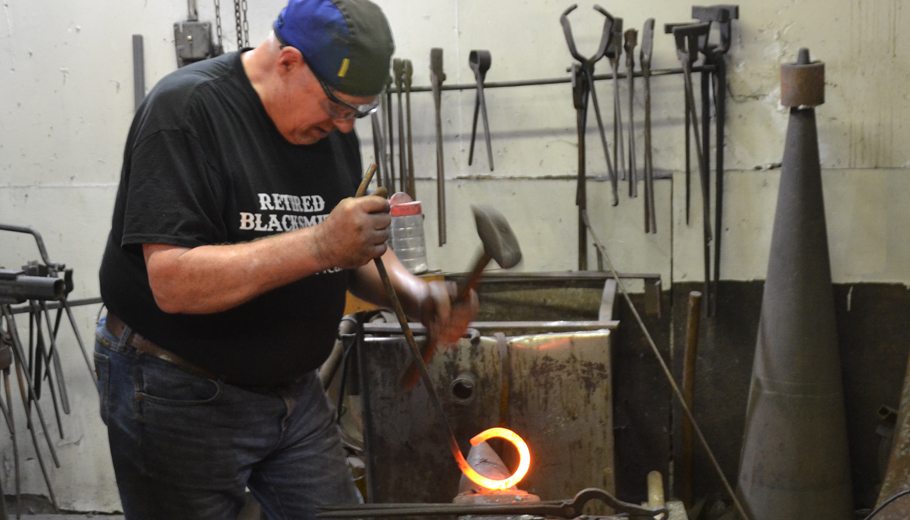
Sharing knowledge forged in fire
By James Card
Leonard Grewe stoked the forge with new coke and red-hot flames came alive.
“Nobody brought marshmallows?” Grewe asked.
His six students were gathered in a semi-circle and they spent the day learning about metallurgy, blacksmithing history, building a forge and how to set-up a blacksmithing shop. Their project for the day was to forge a small axe head, the kind that would slip onto a tomahawk haft and be handy for camping or trapping.
He started blacksmithing 35 years ago.
“I was always fascinated with metal work and welding so I decided to teach myself how to blacksmith. I bought some heavy plate, built my anvils and went from there,” said Grewe. “There are three questions I ask a blacksmith when I meet a guy that calls himself a blacksmith. What’s the difference between a left-handed and a right-handed hammer? If they don’t know they should go pound something until they find out. What are the melting degrees of high carbon, low carbon, stainless, nickel and wrought? And which direction do you have your anvil facing? That makes a big difference, too,” he said.
Grewe demonstrated the use of historical side-draft forge from upper Michigan.
“When I go to historical events, I go out there with natural charcoal and bellows and a side-draft forge and do it like the way they used to do it. I’m not one of these guys that comes in there with a Sears & Roebuck and pretend I’m back in the 1600s. Back then, you had an anvil, a hammer, maybe a sledge and two sets of tongs and that was your shop,” he said.
“Blacksmiths were often considered an associate of the devil because they always worked in dim buildings so you could see the metal properly. They were always around brimstone and smoke,” said Grewe.
Grewe is a student of history and he shared blacksmithing insights that spanned the globe and centuries: the use of anvils in Milwaukee in World War II, how the French made wrought iron, forging copper axes in the Syrian mountains, the technical intricacies and religious practices of Japanese sword making, the deforestation of eastern forests to feed the kilns of a growing America and how England conspired to control the American colonies by heavily taxing iron and limiting the immigration of experienced blacksmiths.
“Which are you going to throw overboard, a ton of iron or a box of tea?” asked Grewe referring to the Boston Tea Party.
He produced a chunk of iron ore. “That came from Iron Ridge, Wisconsin. That’s about 90% iron oxide. In 1930, it was a leading producer of iron ore. Ever walk through the woods and see rust on the water? That’s iron oxide,” said Grewe.
Grewe plans to host another seminar before Christmas for students to make iron Santa Claus sculptures.
“We’re building things here that’s going to last generations. People don’t realize that with blacksmithing. We’re not building things here to throw away,” he said.
When his oldest grandson placed second at a national power-lifting meet, he made him a replica of Thor’s hammer, a 95-pound sledge hammer resembling the main weapon of the Nordic god of storm and strength.
The blacksmithing seminar costs $75 for Saturday and Sunday. Lunch is included. Saturday is for instruction and Sunday is an open shop for hands-on work. Classes are limited to 4-6 students. Students need safety glasses, protective footwear, a notebook and pen and a cross peen or ball peen hammer.
Grewe can be contacted at 920-470-2641 and at [email protected].
